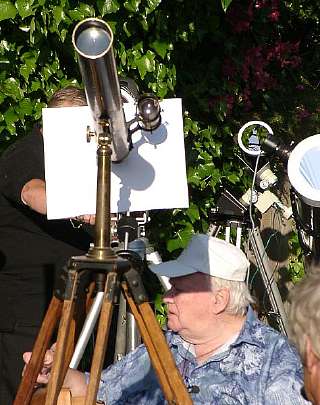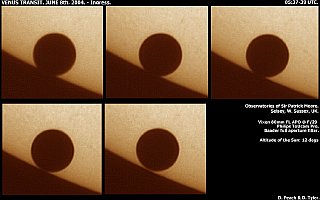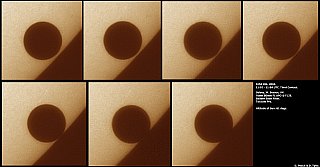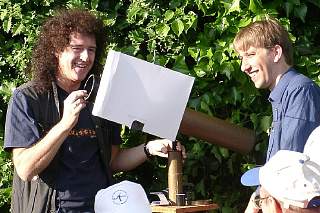Venus transit widely observed
ASTRONOMY NOW SPECIAL REPORT
Posted: June 10, 2004
 |
|
Sir Patrick Moore
observed the transit of Venus from his home in Selsey in between reporting live
for the BBC and recording a Sky at Night special. While others around him chose
high-tech solutions to view the transit, Sir Patrick elected to use his 70-year-old
3-inch refractor to project the Sun's image onto a card.
Image credit: Astronomy Now.
|
|
For thousands of observers across the British Isles, the dawn of Tuesday, June
8th brought the kind of weather they had fervently wished for: clear, cloudless
skies for the transit of Venus. Many keen amateur astronomers had taken the day
off work to see the rare and beautiful sight of our sister planet gliding across
the face of the Sun, an event last seen in 1882.
While most people saw the spectacle from home using binoculars or small telescopes
equipped with solar filters, many gathered at special transit 'parties' like that
at the historic Royal Observatory Greenwich in Greenwich Park, London. BBC presenter
Adam Hart-Davis joined the crowds at Greenwich to bring results from British enthusiasts
in Egypt and the village of Much Hoole in Lancashire at the home of Jeremiah Horrocks,
who saw the transit of 1639.
BBC coverage extended to the home of Sir Patrick Moore in the coastal town
of Selsey, West Sussex, where a veritable forest of telescopes stood trained on
the Sun. Conditions there were excellent, and several observers chose to view
the event in hydrogen alpha (H-α) light. This had never been done before,
so no-one knew quite what to expect.

 |
|
Renowned U.K. planetary
imager Damian Peach was also stationed at Selsey, equipped with a Vixen 80mm apochromatic
refractor, Baader full aperture solar filter and ToUcam Pro Web camera, with which
he secured these images of the ingress and egress of Venus. Click on either montage
for a larger view.
Image credit: Damian Peach / Dave Tyler.
|
|
One of the eagerly anticipated features was the so-called 'black drop', an
effect seen when the disc of Venus is tangential to the Sun's limb and a droplet
or ligament appears between them, making timings difficult. The black drop was
famously evident during the transit of 1769 observed by Captain James Cook in
Tahiti. While many did see (and photograph) the effect this time round, early
reports suggest it didn't manifest itself in H-α light. Others report that
with large aperture, high-contrast instruments it didn't appear at visual wavelengths
either. Clearly, the phenomenon is still far from being explained and rival theories
will be hotly debated in the weeks and months to come.
Another aspect of Venus observation met with a far greater consensus: the
visibility of the Venusian atmosphere. Just after third contact, when the limb of
Venus was exiting the disc of the Sun, many observers around the world reported
(and again photographed) seeing a ring of light concentric with the edge of Venus
on the portion of the planet's globe that was off the face of the Sun. This was
clearly refraction of the Sun's light within the thick atmosphere of Venus.
However, others claim to have seen it before second contact, but the vast
majority of observations have still to be reported.
 |
|
Renowned rock guitarist
and music producer Brian May (now Dr Brian May) joined in the revelry at Sir Patrick
Moore's home and proved he's also an accomplished observer. Here he uses his first
home-made childhood Newtonian reflector to project an image of the Sun for Sky
at Night transit special co-presenter, Chris Lintott.
Image credit: Astronomy Now.
|
|
While large groups of observers were intent on gathering valuable scientific data
and timings, the six hour duration of the transit meant there was plenty of time
to chat and reflect. For many groups, the event took on an air of celebration,
and this was very evident at Sir Patrick's home and gardens in Selsey. Here astronomers
both amateur and professional were able to mingle and reminisce, while legendary
rock guitarist Brian May, now Dr Brian May, showed he was an equally skilled observer.
Even now, astronomers are looking forward to the next transit of June 6th,
2012. Unfortunately for U.K. astronomers, however, this transit will be largely
over when the Sun rises on that day. Third contact will occur with the Sun just
6° above the east-northeast horizon at 5:38 a.m. BST for an observer
at the centre of the British Isles.
For those seeking more information on the 2004 transit of Venus, a joint
British Astronomical Association, Federation of Astronomical Societies,
and Society for Popular Astronomy Web page has a gallery of
observations received so far.
|
 |
 |

|
|



